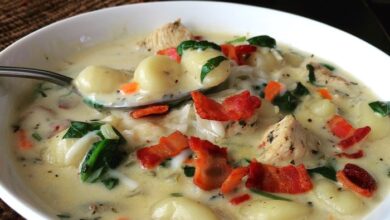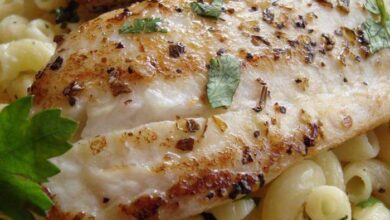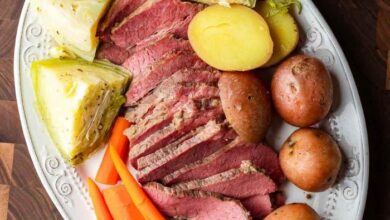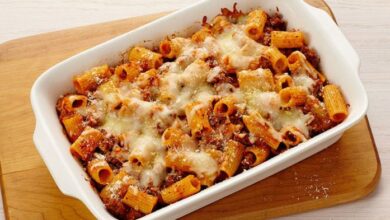
Italian Mac and Cheese: A Delicious Fusion of Flavors
Italian Mac and Cheese: A Delicious Fusion of Flavors. It’s a dish that sparks curiosity and begs the question, “How did these two culinary worlds collide?” The answer lies in a fascinating blend of history, innovation, and the undeniable power of flavor.
Imagine creamy, cheesy pasta, infused with the warmth of Italian herbs and spices, a symphony of textures and tastes that transcends cultural boundaries.
This dish is a testament to the ingenuity of Italian immigrants who brought their culinary traditions to America, enriching the American palate with a touch of the Mediterranean. From humble beginnings, Italian Mac and Cheese has evolved into a culinary masterpiece, reflecting the ever-changing landscape of American cuisine.
The History of Italian Mac and Cheese
Italian Mac and Cheese, a delicious fusion of American comfort food and Italian flavors, has a fascinating history. This dish represents the dynamic interplay between culinary traditions, immigrant influences, and the evolution of American cuisine.
The Origins of Italian Mac and Cheese
The origins of Italian Mac and Cheese can be traced back to the arrival of Italian immigrants in the United States in the late 19th and early 20th centuries. These immigrants brought with them their rich culinary traditions, including the use of fresh herbs, tomatoes, garlic, and cheeses like Parmesan and Romano.
The Influence of Italian Immigrants on American Cuisine
Italian immigrants had a profound impact on American cuisine. They introduced new ingredients, cooking techniques, and dishes that became staples in American kitchens. The influence of Italian immigrants is evident in the popularity of dishes like pizza, spaghetti, and meatballs.
The Evolution of Mac and Cheese
Traditional American Mac and Cheese is a simple dish made with macaroni pasta, butter, flour, milk, and cheese. It is a comforting and familiar dish that has been enjoyed by generations of Americans.
Incorporating Italian Flavors into Mac and Cheese
Italian immigrants, seeking to recreate familiar flavors in their new home, began to incorporate Italian ingredients into American dishes. This led to the creation of Italian Mac and Cheese, a dish that blends the familiar comfort of American Mac and Cheese with the bold flavors of Italian cuisine.
The Ingredients of Italian Mac and Cheese
Italian Mac and Cheese typically includes ingredients like:
- Macaroni pasta
- Butter
- Flour
- Milk
- Cheeses (Parmesan, Romano, Fontina, Provolone)
- Garlic
- Onions
- Tomatoes
- Fresh herbs (basil, oregano, parsley)
The combination of these ingredients creates a dish that is both creamy and flavorful, with a distinct Italian character.
Variations and Regional Influences
While the basic concept of pasta with cheese is universal, Italian Mac and Cheese takes on a variety of regional interpretations, reflecting the diverse culinary traditions and local ingredients found across the country. These variations highlight the richness and complexity of Italian cuisine, showcasing the unique flavors and textures that make each region’s Mac and Cheese distinct.
Regional Variations
The variations in Italian Mac and Cheese are a testament to the diverse culinary landscape of Italy. From the mountainous regions of the north to the sun-drenched islands of the south, each area boasts its own unique spin on this classic dish.
Northern Italy
- Lombardy:Known for its rich dairy products, Lombardy features Mac and Cheese dishes that often include creamy cheeses like Fontina, Gorgonzola, and Taleggio. These cheeses add a pungent and complex flavor to the dish, often paired with butter and cream for a luxuriously rich texture.
- Piedmont:The region of Piedmont is famous for its truffles, and these prized fungi often make their way into local Mac and Cheese recipes. The earthy aroma and flavor of truffles elevate the dish to new heights, creating a truly decadent experience.
- Veneto:In Veneto, Mac and Cheese is often made with a blend of cheeses like Asiago, Parmesan, and Pecorino Romano, creating a savory and nutty flavor profile. The region’s proximity to the sea also influences the dish, with seafood like mussels or clams sometimes added for a briny touch.
Central Italy
- Tuscany:Tuscany’s Mac and Cheese often features a blend of Pecorino Romano and Parmesan, resulting in a sharp and salty flavor. The region’s culinary focus on simplicity and fresh ingredients is reflected in the dish, with minimal additions beyond the cheese and pasta.
- Umbria:Umbria’s Mac and Cheese often incorporates local specialties like black truffles or porcini mushrooms, adding an earthy and aromatic depth to the dish. The region’s rolling hills and fertile valleys provide an abundance of fresh produce, which may also be incorporated into the Mac and Cheese.
- Lazio:Lazio’s Mac and Cheese often features a combination of Pecorino Romano, Parmesan, and ricotta cheese, creating a creamy and flavorful sauce. The region’s proximity to the sea sometimes leads to the addition of seafood like shrimp or clams, adding a briny note to the dish.
Italian mac and cheese is a comforting dish, but sometimes I crave something lighter and brighter. That’s when I turn to a simple easy feta tomato pasta – it’s a perfect blend of tangy feta, sweet tomatoes, and vibrant herbs.
The flavors are fresh and vibrant, and the dish comes together in a flash. But, don’t get me wrong, there’s a special place in my heart for a creamy, cheesy Italian mac and cheese – it’s the ultimate indulgence.
Southern Italy
- Sicily:Sicilian Mac and Cheese often features a blend of sharp cheeses like Pecorino Romano and Caciocavallo, creating a bold and savory flavor. The region’s culinary influences from North Africa and the Middle East are reflected in the use of spices like cinnamon, nutmeg, and saffron, adding a touch of warmth and complexity to the dish.
- Campania:Campania’s Mac and Cheese often incorporates local specialties like buffalo mozzarella and ricotta salata, creating a creamy and tangy sauce. The region’s culinary focus on fresh seafood is also reflected in the dish, with anchovies or other seafood sometimes added for a briny touch.
- Puglia:Puglia’s Mac and Cheese often features a blend of Pecorino Romano and ricotta cheese, creating a creamy and salty sauce. The region’s culinary focus on simple and rustic flavors is reflected in the dish, with minimal additions beyond the cheese and pasta.
Cooking Techniques and Methods
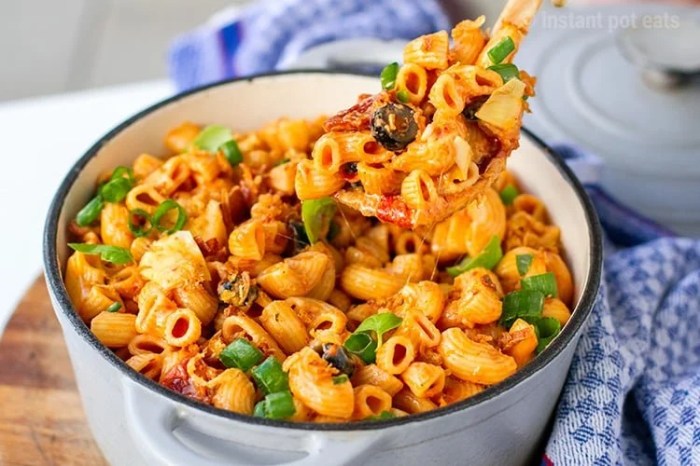
Italian Mac and Cheese, like any other culinary masterpiece, thrives on the art of mastering specific cooking techniques. The process involves more than just tossing pasta with cheese; it’s a harmonious blend of precise methods that elevate the dish to new heights of flavor and texture.
Sauce Making, Italian mac and cheese
Creating a luscious and flavorful sauce is the foundation of a truly satisfying Italian Mac and Cheese. The key lies in understanding the interplay of different ingredients and their impact on the final outcome.
Traditional Techniques
The traditional approach often involves creating a béchamel sauce as the base. This involves a delicate balance of butter, flour, and milk, slowly whisked together over low heat until it reaches a smooth and velvety consistency. This creamy base then serves as the canvas for incorporating other flavorful ingredients, such as grated cheese, herbs, and spices.
Innovative Approaches
Beyond the traditional béchamel, modern interpretations explore innovative sauce-making techniques. Some chefs utilize a combination of cream and cheese, creating a rich and decadent sauce that melts beautifully over the pasta. Others opt for a lighter, more vibrant sauce using a base of white wine or vegetable broth, infused with aromatic herbs and spices.
Tips for Achieving a Perfect Sauce
Use high-quality cheese
The quality of the cheese directly impacts the flavor and texture of the sauce. Opt for sharp cheeses like Parmesan, Pecorino Romano, or Fontina, which add depth and complexity.
Control the heat
Avoid overcooking the sauce, as it can become thick and grainy. Maintain a low heat throughout the process, ensuring a smooth and creamy texture.
Seasoning is key
Don’t be shy with seasoning. Use a generous pinch of salt and freshly ground black pepper to enhance the flavors.
Experiment with flavor combinations
Don’t be afraid to get creative with your sauce. Incorporate fresh herbs, roasted garlic, or even a touch of chili flakes for a spicy kick.
Pasta Cooking
The pasta itself plays a crucial role in the success of Italian Mac and Cheese. Choosing the right pasta type and cooking it to perfection is essential for achieving a harmonious dish.
Pasta Selection
Short pasta shapes
Penne, rigatoni, and elbow macaroni are excellent choices for Italian Mac and Cheese. Their shape allows for the sauce to cling to the pasta, creating a flavorful and satisfying bite.
Consider the sauce
If you’re using a thick and creamy sauce, a smooth pasta shape like orecchiette or cavatappi works well. For a lighter sauce, a more textured pasta like farfalle or fusilli provides a pleasing contrast.
Pasta Cooking Techniques
Use plenty of water
Ensure there is enough water to cook the pasta evenly. Aim for a ratio of 10 parts water to 1 part pasta.
Salt the water
Adding salt to the water enhances the flavor of the pasta.
Don’t overcook
Pasta should be cooked al dente, meaning it should have a slight bite to it. Overcooked pasta will become mushy and lose its texture.
Reserve some pasta water
Italian mac and cheese, with its creamy sauce and sharp Parmesan, is a dish that begs for a sweet and salty counterpoint. That’s where Alexanders chocolate covered peanuts come in, their rich chocolate and crunchy peanuts offering a delightful contrast to the savory pasta.
The combination is a perfect example of how sweet and savory can beautifully complement each other, making the Italian mac and cheese experience even more satisfying.
Starchy pasta water can help thicken the sauce and create a creamy consistency.
Assembly and Finishing Touches
Once the pasta is cooked and the sauce is prepared, it’s time to assemble the Italian Mac and Cheese.
Assembly
Combine pasta and sauce
Gently toss the cooked pasta with the prepared sauce, ensuring each strand is coated evenly.
Add cheese
Incorporate additional cheese, such as shredded mozzarella or ricotta, to add creaminess and richness.
Bake or broil
For a golden crust and extra cheese melt, bake or broil the dish until the cheese is bubbly and golden brown.
Finishing Touches
Garnish
Add a sprinkle of fresh herbs, such as parsley or basil, for a burst of flavor and visual appeal.
Serve immediately
Enjoy the Italian Mac and Cheese while it’s hot and fresh.
Variations and Regional Influences
Italian Mac and Cheese is a versatile dish that lends itself to endless variations, influenced by regional culinary traditions and personal preferences.
Regional Variations
Southern Italy
Mac and Cheese in the south often features a rich tomato-based sauce, incorporating ingredients like San Marzano tomatoes, garlic, and oregano.
Northern Italy
In the north, the dish might be more cream-based, with the addition of butter, Fontina cheese, and nutmeg.
Innovative Variations
Truffle Mac and Cheese
This luxurious variation features the earthy aroma of black truffles, adding an extra layer of complexity and indulgence.
Spicy Mac and Cheese
For a fiery kick, add a pinch of red pepper flakes or a drizzle of hot sauce.
Vegetarian Mac and Cheese
Replace the traditional cheese with a vegan alternative, such as cashew cream or nutritional yeast, for a plant-based option.
Italian mac and cheese is all about the creamy, cheesy goodness, but sometimes you crave something a little more smoky and savory. That’s where the magic of slow-smoked pulled pork comes in. If you’re looking for a recipe that’ll have you drooling, check out this bobs pulled pork on a smoker recipe.
It’s the perfect way to add a touch of BBQ to your next Italian mac and cheese night.
Serving Suggestions and Pairings: Italian Mac And Cheese
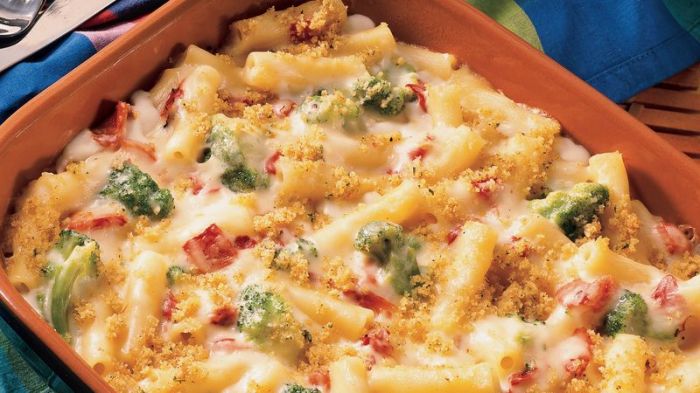
Italian mac and cheese, with its rich flavors and creamy texture, is a dish that can be enjoyed in many different ways. Whether you’re serving it as a main course or a side dish, there are plenty of options for pairing it with other foods and beverages.
The key to successful pairings is to consider the flavors and textures of the mac and cheese. The dish is typically rich and cheesy, with a slightly sweet and savory flavor profile. Therefore, it pairs well with other foods that complement these flavors, such as grilled meats, roasted vegetables, and fresh salads.
Wine Pairings
Wine pairings for Italian mac and cheese can range from light and refreshing to bold and complex. The best choice will depend on the specific ingredients in the mac and cheese and your personal preferences.
| Wine Style | Recommended Pairing | Description |
|---|---|---|
| White Wine | Pinot Grigio, Sauvignon Blanc | These wines offer crisp acidity and light fruit flavors that complement the creamy texture of the mac and cheese. |
| Red Wine | Chianti, Barbera | These Italian red wines have a moderate tannin level and fruity notes that pair well with the savory flavors of the mac and cheese. |
| Sparkling Wine | Prosecco, Lambrusco | The bubbles in these wines help to cut through the richness of the mac and cheese, while the fruity flavors complement the dish. |
Beer Pairings
Italian mac and cheese can also be paired with a variety of beers. The best choices will depend on the style of mac and cheese and your personal preferences.
- Pale Ale: A pale ale with a slightly hoppy bitterness can cut through the richness of the mac and cheese.
- Amber Ale: An amber ale with caramel and toffee notes complements the sweetness of the mac and cheese.
- IPA: An IPA with a strong hoppy flavor can provide a contrast to the creamy texture of the mac and cheese.
Cocktail Pairings
For a more adventurous pairing, consider serving Italian mac and cheese with a cocktail.
- Negroni: The bitter notes of the Negroni complement the savory flavors of the mac and cheese.
- Aperol Spritz: The refreshing and slightly bitter Aperol Spritz provides a nice contrast to the richness of the mac and cheese.
- Bellini: The sweetness of the Bellini complements the creamy texture of the mac and cheese.
Side Dish and Appetizer Pairings
Italian mac and cheese can be served as a main course or as a side dish. If you’re serving it as a side dish, consider pairing it with grilled meats, roasted vegetables, or fresh salads. If you’re serving it as a main course, consider adding a few appetizers to round out the meal.
- Caprese Salad: The fresh flavors of tomato, mozzarella, and basil complement the richness of the mac and cheese.
- Bruschetta: Toasted bread topped with olive oil, garlic, and tomatoes provides a light and flavorful appetizer.
- Arancini: Fried rice balls filled with cheese and meat provide a savory and satisfying appetizer.
Cultural Significance and Impact

Italian Mac and Cheese, though not a traditional Italian dish, has become deeply ingrained in Italian-American culture, representing a fusion of culinary traditions and a testament to the adaptability of food. This dish embodies the spirit of American ingenuity, taking inspiration from Italian ingredients and techniques while embracing American comfort food sensibilities.
The Role of Italian-American Cuisine
Italian-American cuisine has always been about adaptation and innovation. Italian immigrants, upon arriving in America, often had to modify their recipes to accommodate local ingredients and palates. This process led to the creation of dishes like Italian Mac and Cheese, which blended Italian flavors with American staples.
It is a dish that reflects the experiences of Italian-Americans, their cultural heritage, and their ability to create something new and delicious from what was available to them.
Impact on Contemporary Food Trends
Italian Mac and Cheese has had a significant impact on contemporary food trends, contributing to the growing popularity of fusion cuisine. The dish’s ability to combine the familiar flavors of macaroni and cheese with the richness of Italian ingredients has inspired chefs and home cooks alike to experiment with new flavor combinations.
Its presence on menus across the country has also helped to popularize the use of Italian cheeses like Parmesan and ricotta in American cuisine.
Stories and Anecdotes
Italian Mac and Cheese holds a special place in the hearts of many Italian-Americans. Family recipes, passed down through generations, often feature unique twists and variations. These recipes are not just about food but also about family history, shared memories, and cultural identity.
For instance, many families have their own special blend of cheeses, or they might add specific herbs or spices that reflect their regional origins. These variations, passed down from generation to generation, serve as a reminder of the dish’s cultural significance and its ability to connect people to their heritage.

